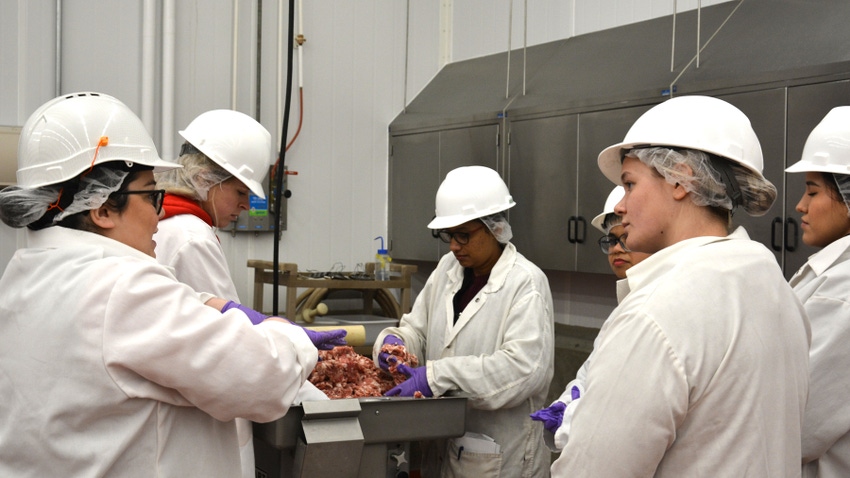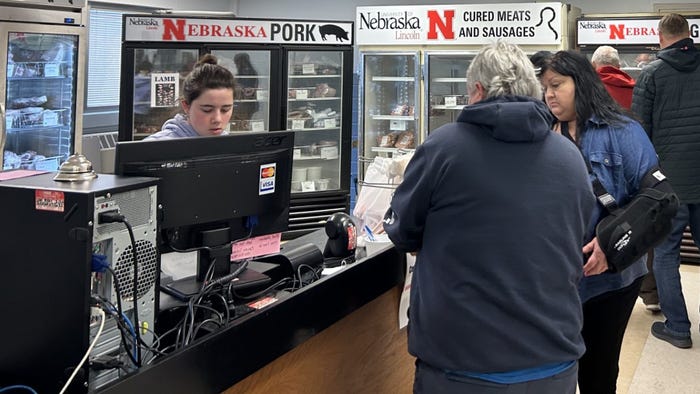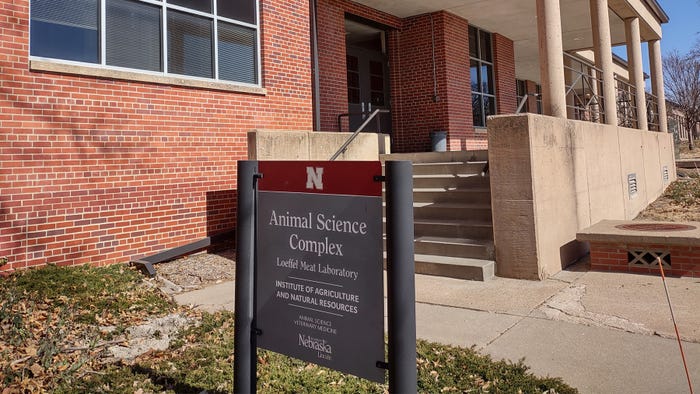
“The legacy of meat science in Nebraska is not the only aspect that drew me to Nebraska,” says Jordan Wicks, assistant professor and meats Extension specialist at the University of Nebraska. “This is the beef state and the meat state — this is where meat processing is happening.”
From the McRib to the flat iron steak, UNL has a rich history of meat innovation. But that does not seem to be slowing down anytime soon. The hands-on opportunities, along with the networking that the university has to offer, is a great place for students to gain the training to make an impact in meat science.
A student-first mindset
Undergraduate student workers in the meat lab learn from professors who have years of experience in a hands-on capacity. But their work is not only needed in the fabrication room. These students create innovative processed products with ideas that originated from other students and can use their own creativity to make new processed meat products.
“This semester, we have some students who are making products for the cured meats competition at the Nebraska Association of Meat Processors convention,” says Gary Sullivan, associate professor of meat science.
UNL students also can enroll in a processed meats class where they curate a recipe for a new product and see it all the way through production. One way that students have seen success through their product development is in the storefront found in the Loeffel Meat Lab. A customer favorite that originated from this class was the sweet heat snack stick.

SERVING THE COMMUNITY: In the meat lab from 11 a.m. to 5:30 p.m. Friday, community members can stop in the storefront to purchase a variety of meat that was processed at the university. Some animals are even sourced from the university’s herd. (Photo by Elizabeth Hodges)
Wicks and Sullivan agree that if students want to learn more about the meat science industry and be prepared to enter the industry after graduation, UNL is the place to be.
“There are nine large beef plants in the state, in addition to three large pork plants,” Sullivan says. “You put that in addition to the number of small processors that we also have in the state, and it is really a unique setting. Because of that impact to the economy, I think it is a sector that will continue to be supported.”
Community impact
One way that the meat lab is making a community impact is through the storefront that is found on East Campus. On Fridays from 11 a.m. to 5:30 p.m., customers can come in to buy beef, pork, lamb, goat and other products in the storefront. In addition, customers can head to the dairy store and find products from the meat lab in the coolers.
Being a USDA-inspected facility gives the opportunity to support other areas of the community outside the university as well.
During the pandemic, UNL partnered with the Nebraska Pork Producers Association to process hogs from area producers to be donated to the Food Bank of the Heartland and the Food Bank of Lincoln.
“By doing that, we were able to help alleviate some of the concerns of pork and potentially the need to euthanize pigs due to shutdowns of the plants,” Sullivan recalls. “But also, we were able to end up donating over 10,000 pounds of pork to the food pantries and those people in need around the state of Nebraska.”
But their commitment to serving does not stop there. The meat lab has partnered with Cactus Cares to provide meat to the student food pantries on both city and East Campus to help students in need. A recent partnership with the dining hall on East Campus is also underway. The meat lab has started supplying the dining hall with different meat products.
If you are looking for a new bratwurst to try, a popular one is the jalapeño popper brat. “The jalapeno popper brats were actually developed for a battle of the brat’s competition for the National and American Society of Animal Science meeting where they were crowned the champion.” Sullivan says. “It was a product that the students worked on and developed and has become a popular product we keep on our regular rotation of products.”
Developing for the future
Pulling together education from the classroom and the hands-on experiences in the meat lab, students can use this to better the community. Wicks draws upon the fact that UNL is a land-grant university, and this is exactly what a land-grant university is all about.
“The goal is to expand our store, expand our accessibility to consumers, and engage them with new products and information,” Wicks says, “even if it is simple little recipe cards or having our students engage with them in conversation.”

LONG HISTORY: Loeffel Meat Lab on East Campus at UNL has been around for more than 60 years, and the meat science innovations coming from that laboratory and those students continues on today. (Photo by Curt Arens)
The students work at the storefront and are equipped with all the knowledge needed to prepare different cuts of meat and assist customers with any questions that they have about the products. By being able to work directly with customers in the community, students can see what products are the most popular and even fill a void if there is a product that customers want but is not offered.
“The storefront really does also provide that real-world experience and completes that process. It is very complimentary to the coursework and the other education that we have here at the university,” Sullivan adds.
The best way to support the work that is happening at Loeffel Meat Lab is to head to the storefront and check out all the offerings available. To find recipes and check out prices, visit animalscience.unl.edu.
Meat science at University of Nebraska
1919: William Loeffel, first UNL meat scientist, was hired.
1953: Loeffel Meat Lab was built.
1972: The National Pork Board awarded Rodger Mandigo, UNL animal science professor, a grant to develop a process to create restructured meats.
1981: McRib was launched to be sold in McDonalds restaurants, with the meat technology innovated by Mandigo’s UNL research team.
2002: The flat-iron cut of beef, found in the chuck primal, was discovered by University of Florida and UNL research teams, including co-discoverer, Chris Calkins, UNL professor of fresh meats,.
2023: UNL was established as one of three Cattle and Carcass Grading Training centers nationwide, alongside Colorado State University and West Texas A&M University.
Read more about:
Meat ProcessingAbout the Author(s)
You May Also Like






